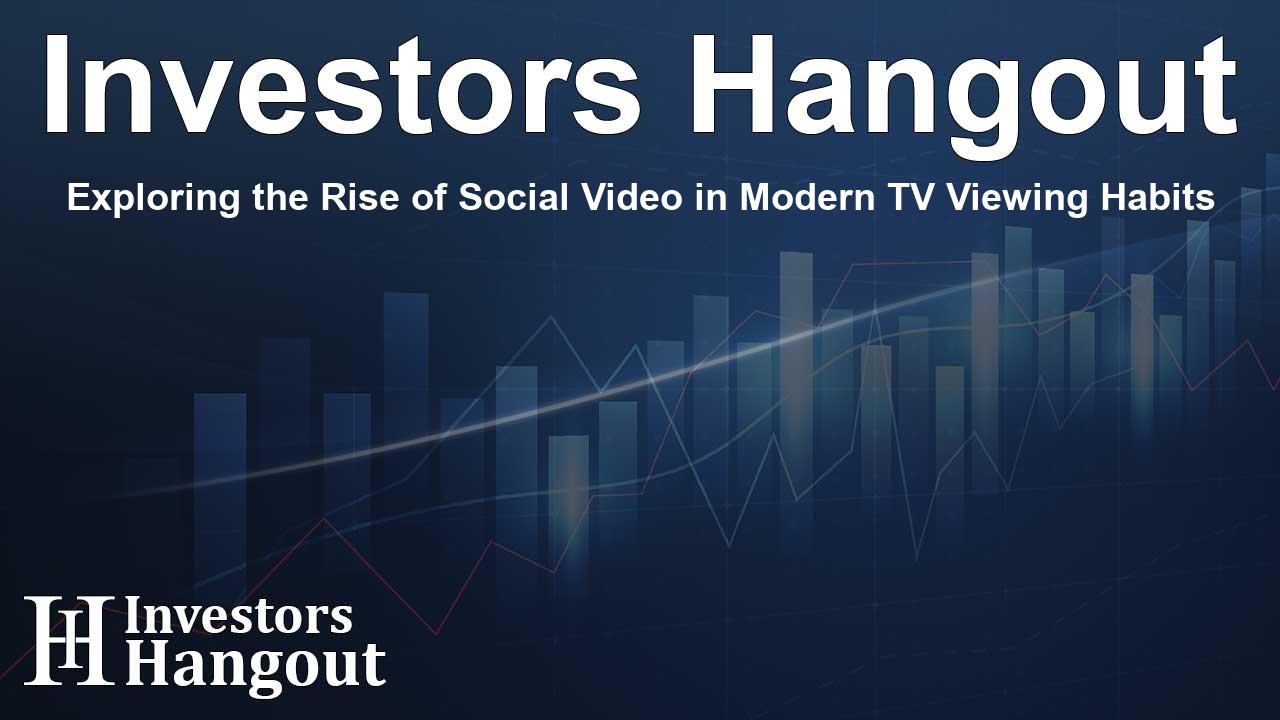Exploring the Rise of Social Video in Modern TV Viewing Habits

Exploring the Impact of Social Video on Television Viewing
Parks Associates has recently released findings that suggest a significant shift in how viewers interact with video content. Their research shows that social video is no longer just a niche activity; it has taken a central role in the media landscape, accounting for nearly five hours of viewing weekly. This trend is shifting dynamics in traditional television consumption patterns.
The Dominance of Platforms like YouTube
According to the data from Parks Associates, platforms like YouTube are at the forefront of this change. Over 20% of all video consumed on television is now categorized as social video, eclipsing traditional pay TV and broadcast viewing. YouTube is particularly noteworthy, with around 9.3 million subscribers to its streaming service, YouTube TV. This surge indicates the growing preference for content offered by individual creators rather than solely established broadcasting brands.
The Role of Content Creators
What sets this evolution apart is the power of content creators. Figures such as MrBeast and Kai Cenat dominate the media landscape, captivating millions with their innovative and engaging content. These individuals are not just entertainers; they are powerful influencers in how audiences consume media, utilizing platforms that allow for greater interaction and connection.
Changing Viewer Habits Across Generations
Among the younger demographic, specifically those aged 18 to 34, social video consumption is rapidly approaching the viewing time of subscription video-on-demand (SVOD) services. Many young viewers are engaging with over 15 hours of social video content weekly, indicating a deepening reliance on these platforms for entertainment. This generational shift is reshaping how streaming services approach content distribution.
Engagement Strategies and Future Trends
Innovative strategies are emerging as the traditional boundaries of streaming services begin to blur. High-profile partnerships, such as MrBeast's collaboration with Amazon MGM Studios, highlight how creators are integrating into mainstream platforms, creating a new business model that combines creativity with commerce. The future of social video is bright, as it integrates into various streaming models.
The Challenge and Opportunity for Streaming Services
As the media landscape evolves, streaming services must adapt. Elizabeth Parks, President and CMO of Parks Associates, underscores the importance of bundling diverse content types—creator-led, studio, and niche content—into unified experiences. This strategy is critical to maintaining viewer engagement in a competitive environment.
Insights from the Future of Video Session
Parks Associates will be discussing these trends in greater detail during their upcoming virtual event focused on the implications of consolidation and aggregation in streaming services. This event will explore how these changes are shaping the future of viewer experiences and what it means for content creators and consumers alike.
Understanding the Broader Context
The research indicates that the rise of social video is not just a fleeting trend but a fundamental shift in consumption patterns. As audiences gravitate towards interactive and engaging content types, traditional media must evolve to meet these expectations. For businesses and marketers, understanding this shift provides valuable insights into consumer behavior and preferences.
Key Takeaways from Recent Research
- Social video now accounts for 4.9 hours per week of viewing time, representing 20% of total television consumption.
- There’s a notable generational shift, with younger viewers increasingly favoring social media platforms for video content.
- YouTube remains the leading platform for social video, shaping consumer habits significantly.
- Collaborations between creators and traditional studios signify a major trend towards integration in the streaming market.
For those navigating the complexities of the streaming landscape, this research from Parks Associates offers a roadmap to understanding viewer preferences. With an ongoing commitment to tracking these trends, Parks Associates is a valuable resource for insights into the dynamics of modern media.
Frequently Asked Questions
What is social video?
Social video refers to video content that is primarily shared and consumed on social media platforms, such as YouTube, TikTok, and Twitch.
How much time do people spend watching social videos?
On average, social video accounts for about 4.9 hours per week of viewing time, which is significant compared to traditional forms of video content.
What demographic is most engaged with social video?
Viewers aged 18 to 34 show the highest engagement with social video, often watching over 15 hours of content each week.
Why is YouTube considered the top social video platform?
YouTube is recognized for its vast user base and the diversity of content offered, making it a preferred choice among video consumers.
What does the future hold for social video?
The integration of social video into mainstream media is expected to grow, presenting opportunities for both content creators and traditional streaming services to innovate and collaborate.
About The Author
Contact Owen Jenkins privately here. Or send an email with ATTN: Owen Jenkins as the subject to contact@investorshangout.com.
About Investors Hangout
Investors Hangout is a leading online stock forum for financial discussion and learning, offering a wide range of free tools and resources. It draws in traders of all levels, who exchange market knowledge, investigate trading tactics, and keep an eye on industry developments in real time. Featuring financial articles, stock message boards, quotes, charts, company profiles, and live news updates. Through cooperative learning and a wealth of informational resources, it helps users from novices creating their first portfolios to experts honing their techniques. Join Investors Hangout today: https://investorshangout.com/
The content of this article is based on factual, publicly available information and does not represent legal, financial, or investment advice. Investors Hangout does not offer financial advice, and the author is not a licensed financial advisor. Consult a qualified advisor before making any financial or investment decisions based on this article. This article should not be considered advice to purchase, sell, or hold any securities or other investments. If any of the material provided here is inaccurate, please contact us for corrections.
